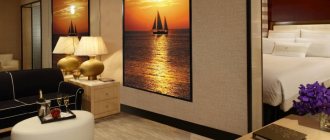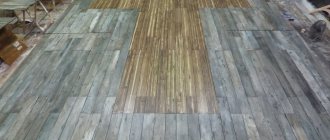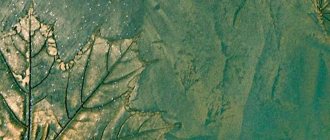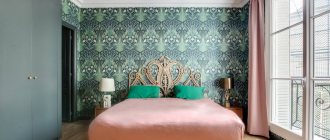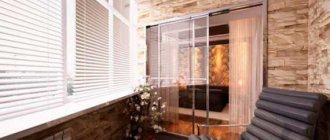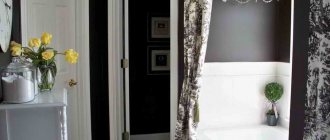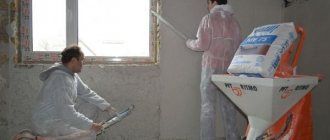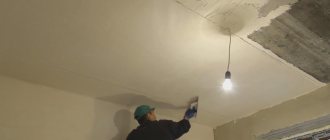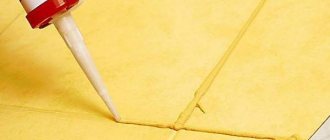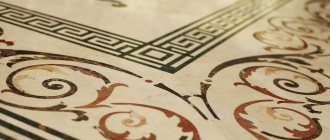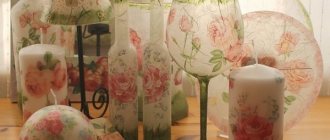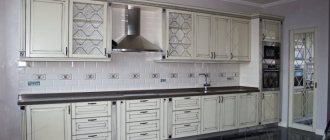Basic floor preparation before painting
- The dry floor is varnished, primed and allowed to sit for three days, after which it is painted.
- Secondary painting is done after the first layer stops sticking. It is advisable to apply the paint with a roller along the length of the boards, achieving the smallest layer.
- The second layer should dry within a week, after which you need to wash the floor with hot water, this operation is repeated every day, achieving maximum removal of drying oil from the surface.
- A floor cleared of drying oil will be less susceptible to contamination and will be much easier to clean.
Painting concrete floors
Concrete floors have a fragile surface that crumbles and becomes dusty. Difficult to remove stains often appear on concrete surfaces. In order to improve the performance of such floors, they can also be painted.
Before painting, the concrete floor is sanded using brushes, special scrubs or a grinding machine. The surface should then be vacuumed and washed to remove dust. The technique and tools for coating concrete surfaces with enamel are the same as for painting wooden floors.
To paint concrete, a special enamel is used, which forms a thin polymer film on the surface, improving the performance properties of the floor. After treatment with this enamel, the floor can be painted with any floor paint.
You can learn more about painting concrete floors by watching the following video:
Complicated floor preparation before painting
If you want to achieve a perfectly smooth painted floor surface, then in this case you will have to complicate the preparation of the floor for painting.
- Initially, the floor is primed, after drying it is puttied with oil putty and this layer is dried.
- The leveled areas are sanded and putty again, and the oil putty should match the color of the floor.
- The dried layer is cleaned with fine-grained sandpaper and primed.
- The paint is applied to the prepared floor several times until the putty areas no longer appear.
How to paint wood floors
Wood floors are the most common. There are a large number of their varieties: planks, parquet, cork, plywood, made of fiberboard and chipboard. Unpainted wooden floors look untidy, wear out quickly and are inconvenient to use.
Choosing paint coatings for wooden floors
Wood floors can be painted with oil paints, alkyd varnishes and enamels, protective alkyd or acrylic impregnations.
- Paints and enamels hide the wood texture and allow you to obtain a uniform color; In this way, plank floors and floors made of fiberboard and chipboard are treated.
- Varnishes allow you to obtain a glossy transparent surface; Parquet floors are usually varnished.
- Protective impregnations protect the wooden floor from destruction; they do not hide the wood texture and can give the wood a selected shade (for example, the color of stained wood).
When choosing paints and varnishes, pay attention to the information on the packaging. Typically, the manufacturer indicates on the label the type of paint or varnish, the surface for which this type of coating is intended, the approximate consumption per 1 square meter, the recommended number of layers, drying time, and also how this varnish or paint can be diluted.
By watching the following video, you will learn which paint is best to paint the floor:
Preparing the floor for painting
Most painting work is preceded by thorough surface preparation. The result of staining depends on the quality of its implementation.
Preparing the floor for painting consists of several stages:
- If there are remnants of previous paint on the surface of a wooden floor, it is better to clean them off with a spatula, sandpaper or a special sanding machine. If this is not done, the old paint will peel off from the wood, reducing the service life of the new coating; It can also show through the new paint layer, detracting from the appearance of the floor.
- If the surface of the wooden floor is uneven, it must be sanded.
- The floor surface is cleaned of dirt using detergents and, if possible, degreased with solvents.
- A new wooden floor should be treated with drying oil before painting - this will reduce paint consumption and increase the life of the floor.
- Using putty, you need to level the floor surface, cover up the gaps between the boards and holes. Instead of putty, you can use a mixture of glue and small sawdust. If you were unable to completely clear the surface of the old paint, you can tint the putty mixture with new paint - this will ensure that the floor surface has a uniform color.
- After the putty has completely dried, you can begin painting.
Painting wooden floors
To paint wood floors, you can use a medium paint brush, a lint-free foam roller, or a sprayer.
They begin work by painting hard-to-reach places with a brush: corners, baseboards and a 15-centimeter strip near them. It is better to paint the rest of the surface with a paint roller - this will allow you to get a more even surface without paint strokes. During painting, you need to stir the paint regularly to avoid streaks.
The average paint consumption is 180-250 grams per 1 m2, but basically you need to focus on the manufacturer’s recommendations indicated on the paint packaging. If the application is too thin, you may soon end up with worn-out stains on the floor. If the paint layer is very thick, the surface may become wrinkled, into which dirt will get clogged.
When painting the floor, one must not forget about ventilation, since most paints have an unpleasant odor and are toxic. In addition, good ventilation can reduce paint drying time. It is not recommended to open doors and windows wide, as dust and dirt may get on wet paint, and this will deteriorate the quality of the surface.
The paint is applied in 2 layers parallel to the direction of the boards. The second layer is applied only after the previous one has completely dried.
How to open up a wooden floor with varnish
Since the varnish coating is transparent, the wooden floor should be sanded. Sanding is the removal of old paintwork, which also eliminates dirt and damage to the floor surface. Sanding is carried out using a special grinding machine or sandpaper No. 40-120.
After sanding, the surface is completely cleaned of dust using a vacuum cleaner.
Varnish is applied using the same method and tools as painting. The only differences are that the varnish needs to be warmed up a little before use, and it takes longer to dry.
After watching this video, you will learn in more detail about sanding and varnishing a parquet wooden floor:
Professional floor preparation for painting
The third method involves high-quality floor painting.
- Preparing the floor for painting is carried out in stages, the surface is drying oil and putty, after drying it is cleaned and putty again.
- A primer is applied to the dried layer of putty and painted in three layers.
- In some cases, after the second leveling, gauze is pulled over the entire surface and embedded in the putty mixture.
- After stripping the second layer, apply a final layer of putty over the gauze.
- The dried layer is sanded, primed and painted three times.
Regardless of which method of painting the floor you use, the important point is to have a strong foundation; if this factor is neglected, then all the work will be in vain.
Due to the deflection of the floor slats, the putty and paint will peel off. In addition, only paint of the same type should be applied to the old coating, otherwise chemical reactions and peeling are possible.
If difficulties arise when repainting an oil coating with oil nitro enamel, then in this case the previous layer should be removed using special solutions. The old layer of paint must be removed to the base; ethyl alcohol or caustic soda are suitable for this purpose. To paint a floor with high quality, the approximate paint consumption can be 230g per square meter.
You can check whether the floor is dry or not by simply pressing your finger, after placing a piece of paper under it. Walk on freshly painted floors with caution. In order not to spoil the fresh coating, you can place pieces of plastic film under your feet. After the floor has dried, the film is carefully removed from the corner.
Water-based paint is usually applied with a brush, along the boards, it is necessary to prevent paint from coming into contact with adjacent floor slats to avoid drips. You can use a spray paint for painting.
When paint dries, it loses its former attractiveness, shine, color saturation fades; this fading process is typical for most paints.
To restore color saturation and shine, it is recommended to varnish the floor surface. You can use nitro varnishes for these purposes; they are durable and abrasion-resistant, but due to their health risks, they are less attractive than polyurethane varnishes.
Polyurethane varnish is initially ready for use; the only recommendation is to thoroughly mix the varnish. Apply 2-3 layers along the length of the floor slats, being careful not to fill the gaps between them.
A floor covered with high-quality paint in compliance with all technological requirements can last up to 5 years.
How do you wash a wooden floor after painting it with enamel?
This procedure can be repeated monthly.
To get rid of limescale in the kettle, pour half a glass of white distilled vinegar and water into it and leave it overnight. If the residue still remains, then boil another half cup of white distilled vinegar in a kettle for a few minutes, let it cool and rinse with plain water.
To remove tags or price tags, attach a cloth soaked in distilled white vinegar. The fabric is left overnight, and by the morning the label can be easily removed!
You can get rid of mold and soap deposits in your bathtub or shower by wiping the surface with undiluted white distilled vinegar. Then the surface is rinsed with water.
To deodorize the toilet, pour three glasses of white distilled vinegar into the toilet and leave it for half an hour, then flush it.
To remove paint from windows, doors or glass, use hot, undiluted white distilled vinegar. Allow some time for the paint to soften, and then remove it with a razor blade.
You can wash and disinfect your child's or pet's toys in soapy water with the addition of a small amount of white distilled vinegar.
You can clean sticky scissors using a cloth soaked in white distilled vinegar.
You can clean your grill by spraying white distilled vinegar onto crumpled aluminum foil and then vigorously scrubbing the grill with the foil.
To clean and deodorize the countertop, wipe it with a cloth soaked in undiluted white distilled vinegar.
Cleaning with Vinegar: Windows and Mirrors
Many cleaning product manufacturers are starting to offer eco-friendly options for their glass cleaners, but perhaps one of the greenest options is vinegar cleaning. Use a simple solution - 2 tablespoons of vinegar per liter of water and newspaper used to clean glass instead of paper towels. If vinegar isn't an option for you (if you have a lot of windows to clean and you're worried the smell might be too strong), lemon juice or baking soda are good alternatives.
Cleaning with Vinegar: Odors
Vinegar is great for removing unpleasant odors from your clothes, as well as sweat stains. Placing a cup of vinegar on your counter will quickly rid the room of unpleasant odors.
Cleaning with vinegar: dry cleaning
Cleaning clothes with vinegar is an easy and inexpensive way to deodorize clothes. Many people already know that white vinegar in a small bowl is great for removing smoke odors and musty odors, and that you can simply place a bowl of vinegar on the floor of a closet or on a shelf if your coat or jacket has become saturated with these odors. But what most people don't know is that if you add white vinegar to the water at the beginning of the wash cycle, it will refresh and soften your clothes during the wash process. The smell of vinegar will miraculously disappear before the end of the wash, and all your laundry will have a very fresh scent. You don't need a lot of vinegar - half a glass will be enough, a full glass will be too much, the exact value is not necessary. Don't forget to add your regular detergent too!
Get your plumbing sparkling clean with vinegar
Vinegar Cleaning: Plumbing
Toilet cleaners that remove rust stains on the market today can be very toxic. Instead of these products, you can use vinegar by applying it to the surface of the toilet and leaving it for about 15 minutes. After this, you need to wash it as usual. The same mixture you used to clean your windows can also be used to shine all the china and fixtures in your bathroom. In addition, it is excellent for killing bacteria.
Vinegar Cleaning: Floors
Cleaning your floor with a solution of one cup of vinegar per liter of water will make the surface shinier.
